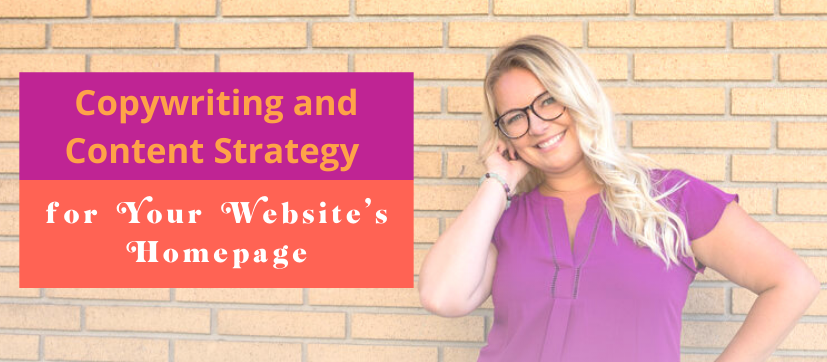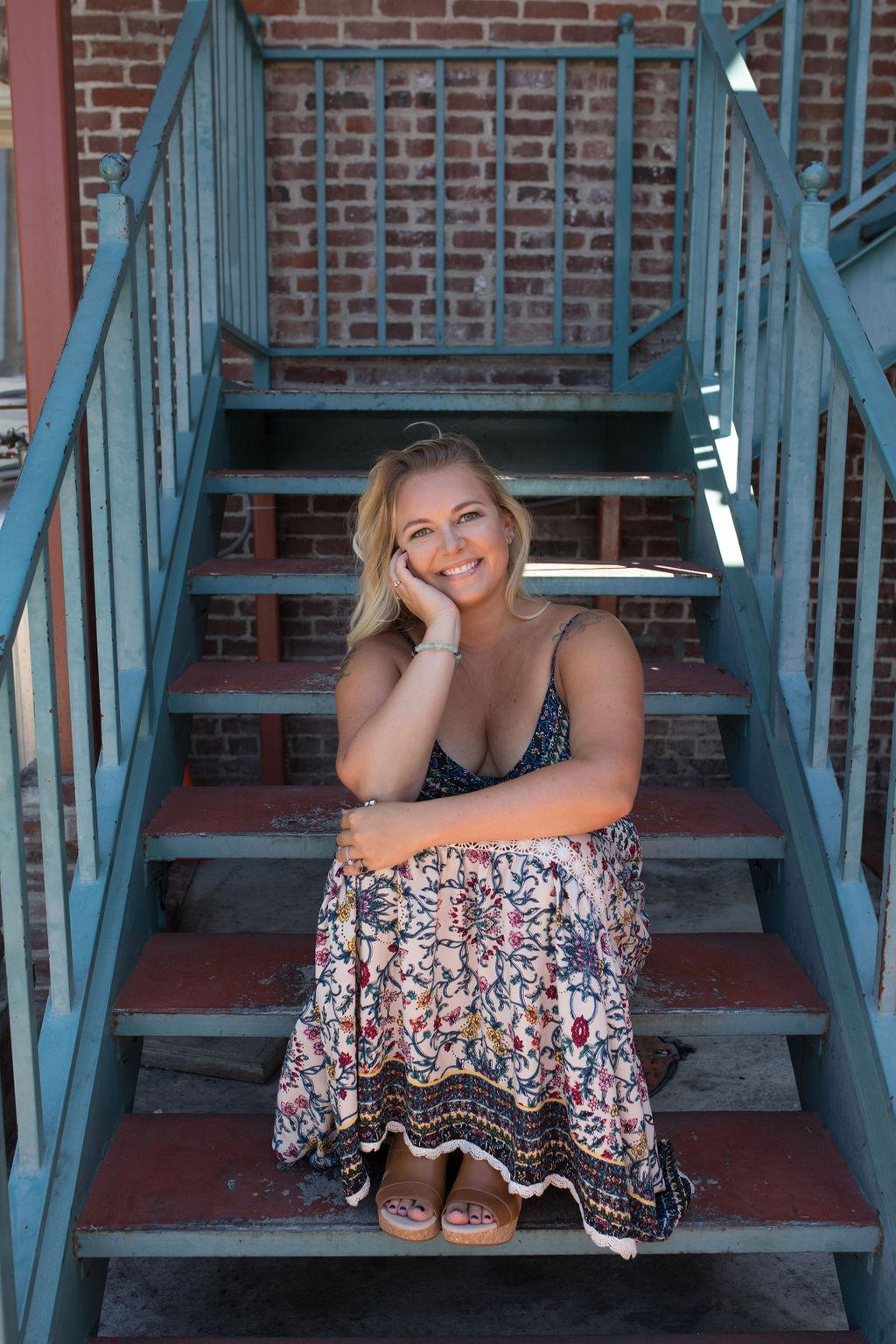Copywriting and Content Strategy for Your Website’s Homepage
Copywriting and Content Strategy for Your Website’s Homepage

Learn how to strategize, structure and create an authentic and successful homepage for your business website.
Are you building your website and struggling to get that homepage just right? We can fix it! Let’s go on a journey through homepages. Buckle up for some hot tips on content strategy, ideas for what modules to include, what style of copywriting you should use and the importance of putting the right kind of energy into your work. From top nav to footer, you’ll learn how to structure and write a homepage that will resonate with your soulmate clients and customers.
Homepages
If you have a website for your personal brand or business or you’re working on one for a client, you are likely going to start with the homepage. Some websites are just 1 big homepage and that’s totally fine. Having a 1 page site is an option that is totally functional and can work great for your brand. But here we are going to talk about homepages for a small personal brand or small brand website. This would be for people like coaches, retail stores selling crafts, creatives, or a service provider such as myself. (I offer copywriting services and online business strategy on a small website.) So these sites would mainly be the basic drag and drop template sites such as Squarespace, Wix, or WordPress. The typical site would have a homepage and a few secondary pages but nothing too crazy.
So if you are asking yourself, what is a homepage? It is the main page on your site and the first thing people are going to see when they type in your url. In other words, it’s important! And even if your website is good to go, this is still great info, because you can apply these principles to landing pages and sales pages as well, if you are planning to launch a new product or service.
Top Navigation Bar
Let’s start at the top, literally. The top nav bar – as the cool kids call it – is the very top of the page where it lists out the different pages, so that people can navigate their way through your website. Some of these items typically include: About page, Services, Contact, Blog and any secondary pages that might apply to your brand such as specific courses or products you sell. Those can live on the top navigation as well. I recommend keeping them as streamlined as possible. Having 4-7 items is best so that it doesn’t look too overwhelming. And don’t worry if you have a few items that don’t fit in the top nav, they can always live in the footer at the bottom of your site too – which stays consistent on all pages of your site just like the top nav bar does.
Pick your top navigation items first. My site has About, Services, Contact, Blog, and Shop. A fun tip is that you don’t actually need an item that says Home. Your logo, that is likely to be somewhere in the header of your website nearby, is going to link to your homepage. That is pretty much industry standard. You can have the home item by all means, but most people know they can click on your logo to return to the homepage. That clears out a little real estate to give you a more streamlined look in that top navigation bar.
H1
Below the top nav there is going to be your Header Image. This is where your Headline/H1 is going to live. H1 is an SEO term. Not all websites need to be built using SEO but if you are going to use it, this is where it goes. The headline or H1 needs to be clear and concise, just a couple words long and should contain your main keyword or keyphrase. Directly below that is where your H2 will go which is almost like a tagline sentence. The OG way would be Headline then Sub Header where you could get clever and cutesy but if you are writing for SEO, the simpler the better and make sure it includes your keyword. Plus this gives your visitors a clear, concise idea of what you are all about and what you have to offer right away. If you want to learn how to optimize your SEO check out my quick rundown of SEO basics Amy’s SEO Episode.
User Journey
Before we dive any deeper into the specifics of Homepages, let’s discuss a strategy. Before you create your content you want to map out your user journey. Some questions you can ask yourself for the user journey are: What’s the point of this page? Why are you making this page on the internet? What action do you want people to take when they are there? How big of a leap or investment is this action? How much thought time are you going to have to give people before you think they’ll take the action you want them to take? How much nurturing do you need to do to get them there? So you basically have to do a little courting before you make any bold moves. Catch my drift?
For example, if you are asking for a big financial investment in something, you probably want to do some more nurturing. You’ll want to inform them more of what the value is and let them get to know you a little better. Or if you want to go the opposite route and just want to provide a quick free opt in, that can live right at the top of your page as well. If it’s really clear what you are offering and it’s a very low risk and low commitment type relationship that you are building, you can ask them to jump into bed with you right away on the first date! You want to create that user journey experience first, so those are some questions you want to ask yourself before choosing all your modules, picking all the content, writing your copy and deciding on visuals, just so you have a clear idea in your head of what the experience is going to be like when someone lands on your homepage.
If you have ever heard the term UX from a developer or strategist, it sounds techy but it actually just means user experience. It’s a thing and these people are professionals at mapping out websites in a way that provides an experience for someone that is really nurturing, that converts, and works. They use some psychology and science to figure it out. If someone lands on this page and they are greeted with a clear headline, so they know what they are getting into, and a little introduction to you, so they like and trust you, then they’ll be more likely to take an action and maybe even make a purchase. Once you have that strategized, you are going to fill in that strategy with different modules on your homepage.
Header
The top module is your Header, which you already have down. If this website is for a personal brand, I highly recommend using an image of YOU. Yes you. People want to see you, they like seeing faces and humanity. I bet if you go look at the insights and analytics of your Instagram feed right now, the posts that contain a picture of yourself or some kind of human element in them perform better than others. The cup of coffee being held versus sitting on the table will always attract more people. We are human and we naturally crave human connection. So don’t be scared to put your mug (not your coffee mug, your face mug) on that header.
CTA
You can consider putting a CTA in the top of your header. CTA is a call to action, which is a button to click that says something along the lines of “Learn More,” “Buy Now,” or “Sign Up.” If you feel like it makes sense for your site, it feels good to you or you think your audience will be so excited to get what you are offering, go ahead and stick that CTA right at the top. Maybe it’s a free coaching call or free downloadable guide, throw it on up there if it works for your site! You can also put a CTA button up there that leads you to a secondary page.
Under your homepage will be the rest of your modules. A good way to map it out is to have a module for each of your secondary pages. Let’s say that the next module under your header is your About page. You would have a little teaser blurb of copy, about your About page, probably with an image, and then a link that says “read more here.” Then you can build out your homepage using those secondary pages as building blocks. Those will all be modules to build out your page and you just work down from there. Let’s move on to our other modules.
Lead Gen
The next item you can throw in there, if it’s not already at the top in your header, is a free lead gen. On my page I offer a free 20+ Ways to Repurpose Your Soul-Driven Content, which you can get HERE. That is my freebie pdf that I give away to people that lives on almost every page of my site along with the homepage. Adding a lead gen right here is a great way to help build your email list and offer your audience something fun and FREE from you!
Testimonials
Another module that is very effective and highly recommended for your Homepage is a Testimonials module. A lot of the templates that you are going to be working with have a Testimonials section built into them already and it’s a great idea to use those and fill them up with people who love you and love your brand. Newcomers are more likely to trust what other people are saying about you versus what you are saying about you. The fancy term we use for Testimonials in marketing is Social Proof. So showing some Social Proof on your homepage is a great idea.
Blogs/Social Media
You definitely want to include a module for your blog. In the template sites, this is usually an option that is already built out for you so it’s very easy. It’s so smart to include your Blog, because it’s going to show your viewer that you are relevant, you’re posting new content, you’re posting value, you are there to support them whenever they need. And it’s a good kick in the pants to keep your blog updated cause it looks a little embarrassing if someone lands on your page and the last blog you have posted was from 2013. Just saying. If blogging is not your jam and you are not going to be posting new and current blogs on your website regularly, then go ahead and skip the blog module altogether because it is going to do more harm than good.
You can instead or also have your social media feed pulled into your homepage. An Instagram feed can look really nice in a lot of cases. You could have a magical developer (because that is what they are) install a widget on your homepage that pulls in your Instagram feed, so that every time you post a photo on your Instagram it will automatically update on your website. Then people will get to see what you have been up to lately, right there on your homepage. Magic!
Contact Form
Another thing you can have on your homepage is a Contact Form. This is a quick and easy way for people to fill out their first name, email address and click “Contact Me” (or whatever CTA wording you want to use) and reach out to you right from that homepage. I would normally have that Contact Form closer to the bottom of the page, because again you want to do a little more of that nurturing beforehand. You want to date before you make that next move.
Footer
The footer is the bottom section of your site, that I mentioned before, that stays consistent throughout the different pages of your site, just like the top nav. Some items you can include in the footer are a link to your blog, social media icons, or an email sign-up. You can go through your top nav items and decide if anything might be more secondary as far as the importance of the user journey of your site, and if they are, then go ahead and move them down to the footer instead. Also, make sure that your copyright date is current so that it doesn’t look like amateur hour. In fact, go add that to your December calendar right now because it’s a personal pet peeve of mine, since it’s such an easy fix.
Copywriting Tips
Use conversational copy! 99% of the clients that I work with prefer to use a conversational copy tone to express the voice of their brand, the vision of their company and their mission in general. It just makes the most sense because people can connect with it. So, if you are writing it for yourself, you want to write like you talk and if you are working with a copywriter, make sure they are familiar with the way you talk so they can use that language in the copy.
I like to send over a big long questionnaire for my website copy clients that has necessary strategic questions but also includes fun questions like If your brand was a car, what car would it be? What’s your spirit animal? Chocolate or Vanilla? All these fun things can give you some insight into their personality and gives you more wiggle room with different things to play with. You want to tap into their slang terms and catch phrases so that it sounds like them! Maybe their brand is ok with cursing, go ahead and drop those F bombs if it makes sense. Do they say ya’ll or you guys? Figure out their voice and style and use that in the copy for their Homepage. Write like you talk, this isn’t english class, you are not going to have someone return it with a bunch of red ink. Use your isms, use your slang just like how you would talk to someone in real life. This is how you expedite the trust process and get people to jump into your offer, or group or buy your products!
Work through your headlines multiple times. Don’t just write it once and say that’s good enough. Write 30 different versions of it, sleep on it, go back, edit it, and have fun with it. The headlines are super important because people are probably just going to scan through the page at first and they are not going to read the body copy. That is just human nature and our attention spans are getting shorter and shorter. So, make those headlines BOMB and take your time to work through them because it’ll definitely be worth your effort.
You also need to pay attention to the energy you are putting into this project. That energy is going to come through with the final product. If you are getting angry and frustrated with creating your homepage, stop, take a minute, walk away, figure out what’s going on, and don’t SHOULD on yourself. You can do a little research about what other people in your field are doing, but don’t do things just because Copywriter Sally over there is doing it that way. Make it as authentically YOU as you can. I mean, what if brands we love just did sloppy seconds versions of what their competitors were already doing? Well I’ll tell you what, they wouldn’t be our favorite brand because no one would give a $h*t about them because they would look like a cheap knock off of someone else! You are better than that. It might take a few iterations too. I am redoing my website too because I realized I was SHOULDING on myself for years! It’s a journey but once you can tap into that authenticity of yourself, you’re going to start seeing super awesome shifts in your business and in your results. It’s fun and exciting so be the most YOU you can be on your homepage.
Taking it Home
There you have it. Take these strategies, tips and tricks and dress your website homepage for success! Build it out to not only function but also nurture your visitors and send them on a friendly journey to learn about what you have to offer. Before you know it, you’ll be bringing in those results by attracting your soulmate clients and customers who couldn’t tear their eyes away from that oh-so-enticing Homepage.
This week’s podcast or show recommendation is : Burnout to Breakthrough with my friend and very first business coach, Erin Nicole Porter. She was there when I made the transition from employee to entrepreneur, has helped me through so many things and is now a personal friend. She was the catalyst to the spiritual journey that I find myself on now, tapping into the spirituality and energetics behind business. And I love her podcast! I’ve been on it and it’s all about strategy and energetics, which is just the best and she also does EFT and hypnotherapy. She does solo episodes and interviews and she just had her 100th episode! So go check her out!
If you want to learn a little more about SEO and the basics behind it, you can check out my blog here for a quick rundown on that: Amy’s SEO Episode
Join the Copywriting Girls Club on Facebook HERE if you want to hang out with me a little more and talk about copywriting and online marketing.
Connect with me on Instagram: @amyleisner
And just one more thing – I’m a strong “repurpose your content” advocate. It saves SO MUCH time and effort when creating all the social media posts, emails, landing pages, email funnels, etc. for your business. I made this “Spread Your Magic” Free Guide that gives you 20+ Ways to Repurpose Your Soul-Driven Content. YOUR words deserve to be read by more people, on more places and platforms. Grab your copy HERE.










